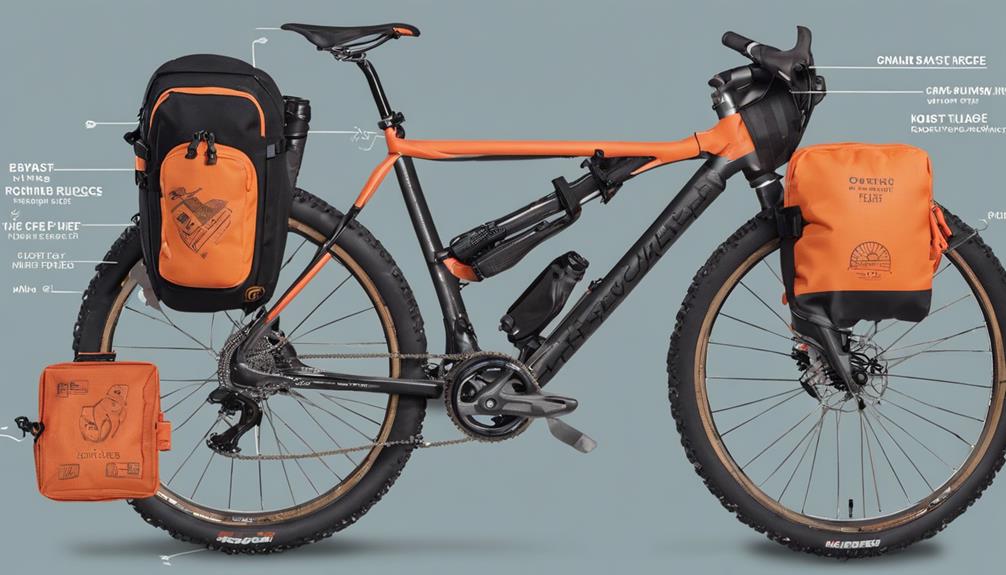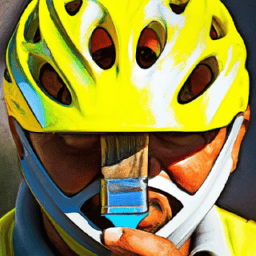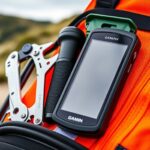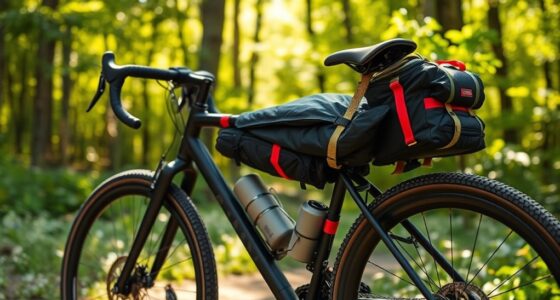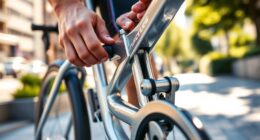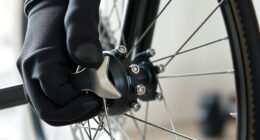Have you ever wondered what items are truly essential to pack in your small bicycle top tube bag for a successful bikepacking trip?
From repair tools to safety gear, the contents of this compact storage space can make or break your adventure.
Let's explore the must-have essentials that will streamline your journey and keep you prepared for any situation.
Key Takeaways
- Carry essential repair tools and items for on-the-go fixes.
- Stay hydrated and fueled with easy access to hydration and nutrition.
- Pack compact clothing and safety gear for changing conditions.
- Include comfort items like a portable jacket and pain relief for long rides.
Essential Tools and Repair Items
When embarking on a bikepacking adventure, it's essential to have a well-equipped kit of tools and repair items to handle unexpected mechanical issues efficiently. In our top tube bag, we always make sure to pack essential tools like a multi-tool, spare tubes, a patch kit, tire levers, and a pump. These items are crucial for addressing unexpected bike repairs while on the go. Whether it's a flat tire, loose bolts, or minor adjustments, having the right tools can make a significant difference in keeping your bike running smoothly during your journey.
Carrying these repair kit items ensures that you can tackle common mechanical issues without relying on external help, making you self-sufficient on the road. By being prepared with the necessary tools, you can quickly address any unexpected bike repairs that come your way, allowing you to focus on enjoying the freedom and adventure of bikepacking without worrying about common maintenance issues. Remember, proper preparation with essential tools can enhance the overall success and enjoyment of your bikepacking trip.
Hydration and Nutrition Supplies

We always prioritize staying well-hydrated and properly fueled during our bikepacking adventures by ensuring our top tube bag is stocked with essential hydration and nutrition supplies. Here are three key items to consider for your top tube bag:
- Hydration Bladders: Opt for a hydration bladder to conveniently sip water without needing to stop. These bladders fit snugly in your bag and have a straw or hose port for easy access, perfect for staying hydrated on the go.
- Insulated Compartments: Choose a top tube bag with insulated compartments to keep your water bottles or hydration reservoirs cool during long rides in hot weather. This feature ensures you have refreshing drinks throughout your journey, even in scorching conditions.
- Secure Attachment: Make sure your top tube bag has a secure attachment system to prevent bouncing or shifting, especially when riding over rough terrain. This feature keeps your hydration and nutrition supplies easily accessible, allowing you to stay focused on the adventure ahead.
Compact Clothing and Accessories

Compact clothing and accessories play a crucial role in enhancing comfort and preparedness during bikepacking expeditions. Small top tube bags are perfect for storing essential items like arm warmers, leg warmers, or a lightweight windbreaker. These bags also provide a convenient space for accessories such as a buff, a spare pair of cycling gloves, or a small first aid kit for emergencies.
Additionally, top tube bags offer quick access to essentials like sunscreen, lip balm, or a small flashlight during bikepacking trips. They're designed to keep personal items like a wallet, keys, or a small camera organized and easily accessible while riding. Compact top tube bags ensure that all necessary items are within reach without adding bulk or extra weight to the bikepacking setup, allowing for a more enjoyable and carefree riding experience.
Safety Gear and First Aid Kit

Transitioning seamlessly from the need for compact clothing and accessories, ensuring safety on bikepacking expeditions involves equipping oneself with essential safety gear and a well-stocked first aid kit. When venturing into the great outdoors on two wheels, being prepared for any situation is key. Here are three vital items to include in your top tube bag:
- First Aid Kit: A compact first aid kit should contain bandages, antiseptic wipes, gauze pads, and adhesive tape to handle minor injuries and accidents swiftly.
- Safety Gear: Equip yourself with a whistle to signal for help in emergencies, an emergency blanket to stay warm, and a compact multi-tool for quick fixes on the go.
- Reflective Gear: Enhance your visibility during low light conditions with reflective gear such as a safety vest or reflective tape to ensure other road users can see you clearly.
Additional Must-Haves for Comfort

Ensuring maximum comfort during bikepacking expeditions involves packing essential items that cater to your needs beyond the basics of safety and first aid.
For comfort essentials, consider carrying a portable insulated jacket to stay warm during chilly evenings or unexpected weather changes. A compact microfiber towel is handy for quick drying after rain or sweat, ensuring you stay comfortable throughout your journey.
Including a small first aid kit with band-aids, antiseptic wipes, and pain relief medication can provide peace of mind in case of minor mishaps.
Don't forget to pack a portable battery pack to keep your electronic devices charged, allowing you to stay connected and navigate your route effectively.
Additionally, a lightweight and compact portable camping stove enables you to prepare hot meals or beverages on the go, adding a touch of homely comfort to your bikepacking adventure.
These small top tube bag essentials can make a significant difference in your overall comfort and enjoyment while on the road.
Frequently Asked Questions
What Do You Put in a Top Tube Bag?
We stash snacks, gels, keys, multitool, and more in our top tube bag. It's handy for quick access to sunscreen, camera, or first aid. Keeping essentials organized and close during bikepacking makes the ride smoother.
Why Don T People Use Panniers for Bikepacking?
We avoid panniers for bikepacking due to their bulkiness and impact on bike handling. Frame bags and handlebar bags offer better weight distribution. Accessibility and versatility are key; hence, the shift to smaller, specialized bags. We choose efficiency and agility over traditional setups.
What Is the Difference Between a Top Tube Bag and a Stem Bag?
We love how a top tube bag sits on the bike's frame, offering ample storage space for gear within reach. Meanwhile, a stem bag near the handlebars provides quick access to snacks or smaller essentials while riding.
How Do You Pack a Bike for Bikepacking?
We load our bikes for bikepacking by placing heavier items low and centered, maintaining light handlebar loads, and testing for security. Avoiding backpacks eases rides. After trips, we optimize packing efficiency by reviewing unused items for future adventures.
Conclusion
As we zip through winding trails and conquer challenging terrains, our small bicycle top tube bag becomes more than just a storage space.
It symbolizes our preparedness, our resilience, and our determination to face whatever obstacles come our way.
It holds the tools and essentials we need to keep moving forward, reminding us that with careful planning and the right gear, we can tackle any adventure that comes our way.
